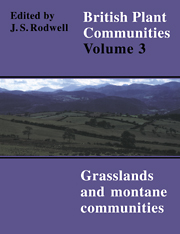Book contents
- Frontmatter
- Contents
- List of Figures
- Preface and Acknowledgements
- Preamble
- Mesotrophic Grasslands
- Community Descriptions
- Calcicolous Grasslands
- Community Descriptions
- Calcifugous Grasslands and Montane Communities
- Community Descriptions
- Index of Synonyms to Grasslands and Montane Communities
- Index of Species in Grasslands and Montane Communities
- Bibliography
MG13 - Agrostis Stolonifera-Alopecurus Geniculatus Grassland
Published online by Cambridge University Press: 04 July 2020
- Frontmatter
- Contents
- List of Figures
- Preface and Acknowledgements
- Preamble
- Mesotrophic Grasslands
- Community Descriptions
- Calcicolous Grasslands
- Community Descriptions
- Calcifugous Grasslands and Montane Communities
- Community Descriptions
- Index of Synonyms to Grasslands and Montane Communities
- Index of Species in Grasslands and Montane Communities
- Bibliography
Summary
Festuca Ovina-Carlina Vulgaris Grassland
Synonymy
Ranunculus repens-Alopecurus geniculatus Ass. R.Tx. 1937; Rumici-Alopecuretum geniculati R.Tx. (1937) 1950 p.p:, Rumex crispus-Alopecurus geniculatus nodum Ivimey-Cook & Proctor 1966 p.p:, Wet alluvial meadows Duffey et al. 1974; Washlands and wet alluvial meadows Ratcliffe 1977; Alopecurus geniculatus vegetation Lee 1977.
Constant species
Agrostis stolonifera, Alopecurus geniculatus.
Physiognomy
The Agrostis stolonifera-Alopecurus geniculatus community comprises open and closed swards dominated by mixtures of the two constant grasses with a variety of occasionals which may be abundant in particular stands. These include Ranunculus repens, Holcus lanatus and Poa trivialis, Glyceria fluitans and, less frequently, G. plicata and G. declinata, a variety of Junci (most frequently J. effusus but also J. articulatus, J. acutiflorus, J. bufonius and J. gerardi) and the tall Rumices, R. crispus and R. conglomeratus. Polygonum hydropiper, Ranunculus sceleratus and Oenanthe fistulosa are distinctive at low frequency. Bryophytes are uncommon, although Brachythecium rutabulum is occasionally conspicuous.
Habitat
The community occurs typically on silty circumneutral soils kept moist and sometimes waterlogged by periodic inundation with fresh water. Often it is found as fragmentary stands alongside sluggish streams and rivers and around pools in lowland pastures, especially where there is moderate poaching by stock. In some areas, however, as in the lowlands of eastern England, it occurs more extensively on the seasonally-inundated alluvium of the flood-plains of large rivers and its often lush herbage can provide valuable summer grazing and an occasional hay crop. On the washlands associated with the drainage systems of the Fens, the community forms part of the patchwork of vegetation associated with a traditional regime of winter flooding and summer grazing. On the Ouse Washes, Cambridgeshire-Norfolk, the largest surviving stretch of washland, now managed by the Royal Society for the Protection of Birds, stands are sheep-grazed in summer to produce a short, tight sward which provides grazing for gathering wigeon (Anas penelope) and Bewick's swan (Cygnus bewickii). Controlled shallow flooding from dykes then creates ideal conditions for dabbling ducks and a further spring flooding transforms the sward to the renowned ‘silver meadows’ which, when re-exposed, are very rich in aquatic fauna attractive to migrant waders.
- Type
- Chapter
- Information
- British Plant Communities , pp. 103 - 104Publisher: Cambridge University PressPrint publication year: 1992



